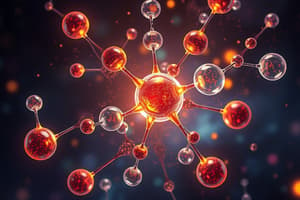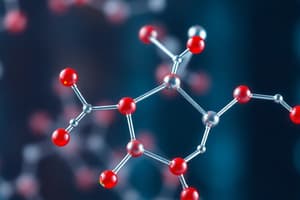Podcast
Questions and Answers
Which of the following cofactors is specifically known as pyridoxal phosphate?
Which of the following cofactors is specifically known as pyridoxal phosphate?
- NAD+
- FMNH2
- TPP
- PLP (correct)
Which characteristic is common among the cofactors PLP, TPP, FMN, and FAD?
Which characteristic is common among the cofactors PLP, TPP, FMN, and FAD?
- They all contain a sulfur atom.
- They are all derived from amino acids.
- They all include phosphate groups. (correct)
- They all have a sugar component.
What is the full form of TPP in the context of organic cofactors?
What is the full form of TPP in the context of organic cofactors?
- Trisphosphate
- Thiamine pyrophosphate (correct)
- Tetrahydropyridine phosphate
- Threonine phosphate
Which of the following is a flavin cofactor that exists in both oxidized and reduced forms?
Which of the following is a flavin cofactor that exists in both oxidized and reduced forms?
What is the primary role of NAD+ in metabolic processes?
What is the primary role of NAD+ in metabolic processes?
What primarily determines the structure and function of proteins?
What primarily determines the structure and function of proteins?
Which of the following statements accurately describes the nature of amino acids?
Which of the following statements accurately describes the nature of amino acids?
What is the role of cofactors in enzyme function?
What is the role of cofactors in enzyme function?
What type of cofactors include metal ions in various oxidation states?
What type of cofactors include metal ions in various oxidation states?
Which of the following describes a property of cofactors?
Which of the following describes a property of cofactors?
Which statement about enzyme-cofactor interactions is true?
Which statement about enzyme-cofactor interactions is true?
Why is the recruitment of additional chemical functionality important for enzymes?
Why is the recruitment of additional chemical functionality important for enzymes?
What happens to an enzyme in the absence of necessary cofactors?
What happens to an enzyme in the absence of necessary cofactors?
What is the main role of organic cofactors in biocatalysis?
What is the main role of organic cofactors in biocatalysis?
Which of the following statements regarding enzymes is correct?
Which of the following statements regarding enzymes is correct?
Which factor does NOT affect enzyme activity?
Which factor does NOT affect enzyme activity?
Which statement about protein structure is true?
Which statement about protein structure is true?
What is a key characteristic of enzymes regarding their substrate specificity?
What is a key characteristic of enzymes regarding their substrate specificity?
What is bound to an enzyme as part of its activation process?
What is bound to an enzyme as part of its activation process?
What type of catalysis is performed by PLP and TPP?
What type of catalysis is performed by PLP and TPP?
Which of the following accurately describes the effect of structural modifications on cofactors?
Which of the following accurately describes the effect of structural modifications on cofactors?
What role does prFMN play in the enzyme activity described?
What role does prFMN play in the enzyme activity described?
Which type of cofactor binds to an enzyme temporarily and is released after the reaction?
Which type of cofactor binds to an enzyme temporarily and is released after the reaction?
Which statement about metal binding sites is true?
Which statement about metal binding sites is true?
What distinguishes a coenzyme from a prosthetic group?
What distinguishes a coenzyme from a prosthetic group?
Which of these is a characteristic of prFMN as described in the content?
Which of these is a characteristic of prFMN as described in the content?
In the context of cofactors, what is meant by a 'metal binding site'?
In the context of cofactors, what is meant by a 'metal binding site'?
Which factor is NOT mentioned as being involved in the activity of the enzyme?
Which factor is NOT mentioned as being involved in the activity of the enzyme?
What defines an organic cofactor in enzymatic reactions?
What defines an organic cofactor in enzymatic reactions?
What is the primary reason that UV-Vis spectroscopy allows for monitoring cofactors above 300nm?
What is the primary reason that UV-Vis spectroscopy allows for monitoring cofactors above 300nm?
What type of molecules are classified as organic cofactors?
What type of molecules are classified as organic cofactors?
What advantage does a protein provide in relation to cofactor activity?
What advantage does a protein provide in relation to cofactor activity?
Which technique is NOT mentioned as effective for studying cofactor binding?
Which technique is NOT mentioned as effective for studying cofactor binding?
What role does the cofactor play in enzymatic reactions?
What role does the cofactor play in enzymatic reactions?
In which technique is protein shielding a significant problem for observing cofactors?
In which technique is protein shielding a significant problem for observing cofactors?
How does the presence of cofactors impact enzyme functionality?
How does the presence of cofactors impact enzyme functionality?
Which statement best describes the relationship between protein and cofactor?
Which statement best describes the relationship between protein and cofactor?
Flashcards are hidden until you start studying
Study Notes
Organic Cofactors
- Organic cofactors are small organic molecules, many of which are vitamins, that bind to enzymes to provide additional functionality required for catalysis.
- Enzymes can often achieve a higher level of function by utilizing the synergy between a protein and a cofactor, which neither can achieve on their own.
Importance of Cofactors
- Enzyme activity is often highly dependent on cofactors, which can be either loosely or tightly associated with the enzyme.
- Cofactors can be inorganic (like metal ions) or organic (like vitamins).
- Cofactors can also be important for structural integrity, and their absence may cause the enzyme to fold improperly or become unstable.
Coenzymes and Prosthetic Groups
- Coenzymes are cofactors that are required to be present in the active site of an enzyme, where substrate binding takes place.
- Prosthetic groups are tightly bound within an enzyme and remain there throughout many reaction cycles.
Overview of Organic Cofactors
- This course will mainly focus on four organic cofactors: PLP, TPP, FMN/FAD, and NAD(P)H.
- These cofactors are complex and contain reactive positions that allow for diverse catalytic reactions.
Studying Cofactor Binding Proteins
- Spectroscopy and structural biology techniques are useful for studying cofactor binding proteins.
- UV-Vis spectroscopy can directly monitor the chemical state of most cofactors, but only above 300nm.
- 1D NMR and IR spectroscopy are less effective as the protein often shields spectral features from the cofactor.
- Mass spectrometry, fluorescence, EPR, and X-ray crystallography are useful techniques for working with cofactors.
- Crystallographic data allows for a mechanistic interpretation of the cofactor-protein interaction.
Studying That Suits You
Use AI to generate personalized quizzes and flashcards to suit your learning preferences.




